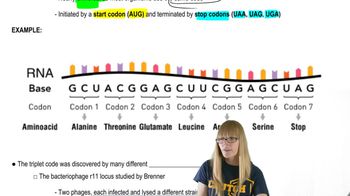Table of contents
- 1. Introduction to Genetics51m
- 2. Mendel's Laws of Inheritance3h 37m
- 3. Extensions to Mendelian Inheritance2h 41m
- 4. Genetic Mapping and Linkage2h 28m
- 5. Genetics of Bacteria and Viruses1h 21m
- 6. Chromosomal Variation1h 48m
- 7. DNA and Chromosome Structure56m
- 8. DNA Replication1h 10m
- 9. Mitosis and Meiosis1h 34m
- 10. Transcription1h 0m
- 11. Translation58m
- 12. Gene Regulation in Prokaryotes1h 19m
- 13. Gene Regulation in Eukaryotes44m
- 14. Genetic Control of Development44m
- 15. Genomes and Genomics1h 50m
- 16. Transposable Elements47m
- 17. Mutation, Repair, and Recombination1h 6m
- 18. Molecular Genetic Tools19m
- 19. Cancer Genetics29m
- 20. Quantitative Genetics1h 26m
- 21. Population Genetics50m
- 22. Evolutionary Genetics29m
7. DNA and Chromosome Structure
DNA as the Genetic Material
Problem 1c
Textbook Question
In this chapter, we first focused on the information that showed DNA to be the genetic material and then discussed the structure of DNA as proposed by Watson and Crick. We concluded the chapter by describing various techniques developed to study DNA. Along the way, we found many opportunities to consider the methods and reasoning by which much of this information was acquired. From the explanations given in the chapter, what answers would you propose to the following fundamental questions: How were scientists able to determine that DNA, and not some other molecule, serves as the genetic material in bacteria and bacteriophages?
 Verified step by step guidance
Verified step by step guidance1
Identify the historical experiments that led to the conclusion that DNA is the genetic material, such as the Griffith experiment, Avery-MacLeod-McCarty experiment, and the Hershey-Chase experiment.
Explain Griffith's experiment, where he discovered the 'transforming principle' by using two strains of Streptococcus pneumoniae bacteria, one virulent and one non-virulent.
Discuss the Avery-MacLeod-McCarty experiment, which identified DNA as the 'transforming principle' by using enzymes to selectively degrade proteins, RNA, and DNA in heat-killed virulent bacteria.
Describe the Hershey-Chase experiment, which used bacteriophages labeled with radioactive isotopes to show that DNA, not protein, is injected into bacteria during viral infection.
Summarize how these experiments collectively provided strong evidence that DNA is the genetic material in both bacteria and bacteriophages.
Recommended similar problem, with video answer:
 Verified Solution
Verified SolutionThis video solution was recommended by our tutors as helpful for the problem above
Video duration:
1mPlay a video:
Was this helpful?
Key Concepts
Here are the essential concepts you must grasp in order to answer the question correctly.
DNA as Genetic Material
The determination that DNA is the genetic material was established through key experiments, notably those by Avery, MacLeod, and McCarty, which demonstrated that DNA from pathogenic bacteria could transform non-pathogenic bacteria into pathogenic forms. This was further supported by the Hershey-Chase experiment, which used radioactive labeling to show that only DNA, and not protein, entered bacterial cells during infection by bacteriophages.
Recommended video:
Guided course

History and Experiments
Structure of DNA
The double helix structure of DNA, proposed by Watson and Crick, is crucial for understanding how genetic information is stored and replicated. This structure consists of two strands of nucleotides twisted around each other, with complementary base pairing (adenine with thymine, and cytosine with guanine) allowing for accurate replication and transmission of genetic information during cell division.
Recommended video:
Guided course

DNA Structure
Experimental Techniques in Genetics
Various experimental techniques, such as transformation assays, radioactive labeling, and molecular cloning, have been developed to study DNA. These methods enable scientists to manipulate and analyze genetic material, providing insights into its role as the carrier of genetic information and allowing for the exploration of genetic functions and interactions in both bacteria and bacteriophages.
Recommended video:
Guided course

The Genetic Code

 9:32m
9:32mWatch next
Master History and Experiments with a bite sized video explanation from Kylia Goodner
Start learningRelated Videos
Related Practice

